Snail Trek is a Sierra-style adventure with modern twists, like autocorrect and autosave
How a thoughtfully crafted text parser can polish the ‘bad’ out of your nostalgic experience.
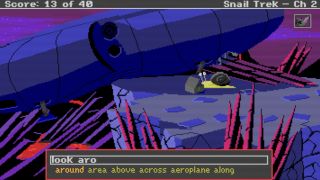
PC gamers, especially us old-timers, often raise the question, ‘Why don’t game developers make X anymore?’ The common answer is, ‘You only think you want X because you don’t remember how bad X was.’ While I’m all for modern games appealing to more people, I do remember how bad X was, when it comes to the quirks of old adventure games, and I still want it, anyway. Have you seen Stair Quest? It’s literally only treacherous staircases, Sierra-style sudden death, and a text parser for interacting with stairs. It’s great.
Sierra released King's Quest in 1983, and in 2018, game developers are still innovating on the text parser. Like Stair Quest, Snail Trek boldly takes a step further back in time than most games would dare, but it's not one big joke about the terrible instant deaths in old adventure games. Snail Trek is an authentic, Sierra-inspired adventure with thoughtfully crafted puzzles and a hilarious story. While he was revisiting an old project, designer/artist Phil Fortier realized there "might be an underserved niche market" for games with text parsers.
He was right: I am that audience, and Snail Trek is a delightfully clever throwback full of smart touches like autosuggest and autocorrect.
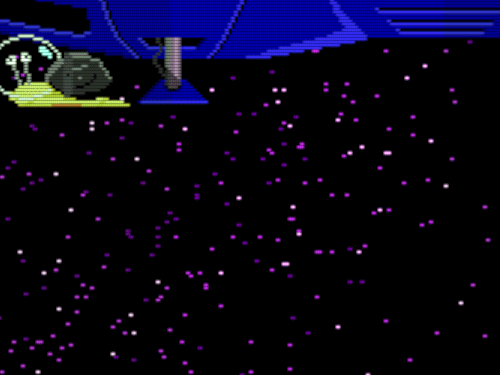
I initially observed ‘snial’ being autocorrected in the first of Snail Trek’s four chapters. I was typing fast. The opening is tense: On reaching the lettuce planet, the crew finds that their captain has disappeared, under highly suspicious circumstances, and there’s no way to send the ‘all green’ signal to their dying homeworld.
“I noticed, during playtesting, that a good third of ‘I don’t understand’ responses were caused by simple typos,” Fortier says. With the fate of all snailkind in my trembling hands, autocorrect is actually pretty great.
The parser also suggests words as you’re typing. Fortier says, “It works like a typical search engine or, more accurately, like a terminal command prompt.” Typing ‘look at let...’ might generate suggestions like ‘lettuce, letter, latch and leak.
“I was worried this could spoil puzzles, but the games' vocabulary is large enough that that’s not the case,” Fortier says. Certainly, I found suggestions included elusive synonyms for objects I already knew existed, but knowing extra words didn’t spoil anything for me.
The biggest gaming news, reviews and hardware deals
Keep up to date with the most important stories and the best deals, as picked by the PC Gamer team.
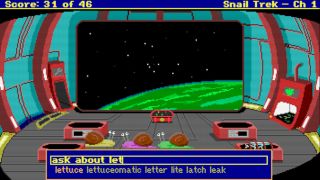
When I typed ‘look’, expecting a description of the wider location, I realized the parser was reacting to my proximity to objects. Fortier explains, “The game understands where the player character is standing, which informs autosuggest results, or lets you omit a noun completely, so you can type ‘look’, ‘get’ or ‘open’ and the game knows you’re talking about the object in front of you.” As well as streamlining input significantly, I found this especially useful for when objects weren’t immediately recognisable against their backdrop, like a ladle or loose panel.
Many adventure games, past and present, expect the player to hunt for what they need in incidental clutter. I recall standing next to objects in Sierra games and typing, “What is that?” to no useful response. Without a point-and-click interface, and no way to reveal hotspots, this parser’s proximal responsiveness alleviates that old frustration well. This also allows for Fortier to make his art and interface feel authentic to 80s games while still making them more playable.
“Early Sierra games used the basic 16 colour EGA palette, then dithered any two together to give the appearance of more colours. Snail Trek’s palette is those 16 colours, plus all the combinations, but in pure form rather than being dithered," he says. "As with the text parser, it’s an attempt to stand out within a crowded market. It may turn people off, but the bright, limited palette catches the eye of anyone who played early adventure games.”
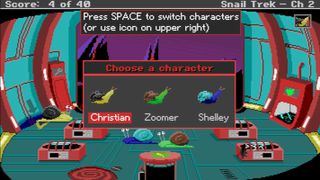
All the deaths, none of the dead ends
Snail Trek's puzzles are better than the ones I remember from the 80s.
Like many early adventurers, I ate the pie in King’s Quest 5, rendering the game unfinishable. That was punishing. I loved it. Many didn’t. In Snail Trek, curiosity can result in sudden death, but there are no unforgiving dead ends like in Sierra's old games. I laughed when I died in Snail Trek, before remembering that I hadn’t saved. Luckily, the game had autosaved, just before I died.
Fortier says, “I'm a fan of death in adventure games, though I know some designers aren't. I've seen recent adventures go to ridiculous lengths to avoid killing the player. Having said this, I didn’t enjoy walking a fine path along a cliff/stairs in old games, although Stair Quest nicely parodies this. It temporarily changes the game from requiring thought to requiring dexterity. It’s also unrealistic, because a person wouldn’t generally fall off stairs. You can still die in my games, but it’s not quite so accidental.”
Fortier is thoughtful about many aspects of the adventure genre. Snail Trek's puzzles are better than the ones I remember from the 80s. He referenced Ron Gilbert’s puzzle dependency charts as a way to visualise choke points and player agency, and always wanted to have multiple, clear goals to occupy the player at any one time. “I put clues into the environment, descriptions of items, or in the game's responses to doing the ‘wrong’ things,” he says.
I particularly liked how the scope for location and story evolved over Snail Trek's four episodes. Although you’re initially limited to the ship, the game grows incrementally, with all areas remaining involved. Towards the end of Chapter 3, I realized I knew the solution to a puzzle because it was a variation on something I’d solved in Chapter 2. I also recalled a sudden death I’d experienced in one chapter, knowing how to use it to my advantage later.
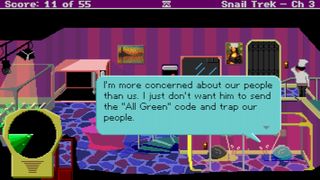
After talking about the design of Snail Trek, I had to ask: Why snails?
“Some people think anthropomorphized snails are cute," Fortier says. "Also, a walk cycle (glide cycle) is very easy to animate.” Although Fortier speaks modestly about his storytelling, I found the narrative well-structured, funny, evocative, and occasionally dark, despite being all about snails.
“Originally, the game was going to take place in a garden, with the snails trying to eat yummy plants. The gardener is trying to grow food and wants to keep the snails out. Who is the real bad guy? Then I thought, everything is better in space!”
It’s hard to explain why, without spoilers, but this proves to be true: Snail Trek, like most things, is better in space. Fortier is now working on a larger adventure with the working title Cascade Quest.
Although currently planning for a similar text parser, Fortier says, “I'm experimenting with offering a point-and-click interface for Cascade Quest, too. It mostly takes place in the wilderness and you’re a non-hero who gets caught up in something bigger than yourself. I'm trying to figure out how much point-and-click would expand my audience and make it easier to localize to other languages, as well as if it takes anything away from the text parser experience.”
Either way, Snail Trek proves that at least some of us do want more genuinely nostalgic games, especially with a smart-parser, autosave and a distinct lack of stairs, to smooth over those bits of design that haven't aged well after 30 years. The Snail Trek Collection is a steal at $3. I loved Princess Rosella, of King’s Quest, when I was a kid. I think I love the hopeful child snail in Snail Trek and her hysterical parents even more. Don’t delay: her survival depends on your ability to type words (at least semi-accurately).
Most Popular


